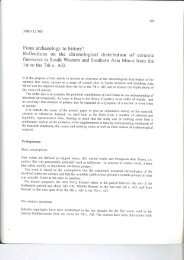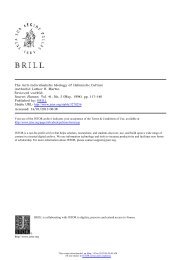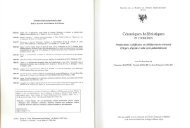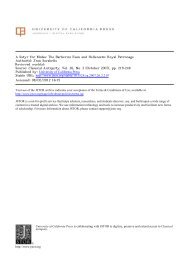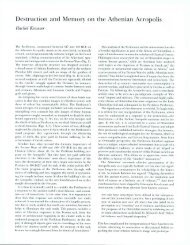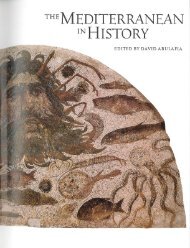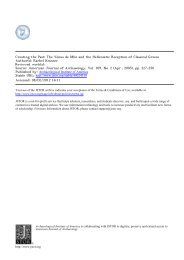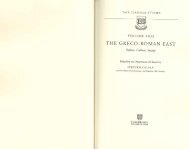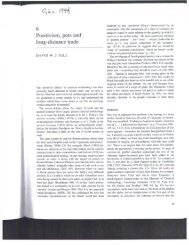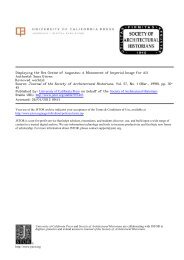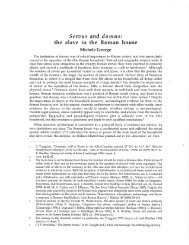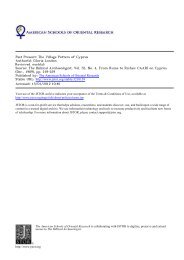John H. Young, “Commagenian Tiaras: Royal and Divine
John H. Young, “Commagenian Tiaras: Royal and Divine
John H. Young, “Commagenian Tiaras: Royal and Divine
Create successful ePaper yourself
Turn your PDF publications into a flip-book with our unique Google optimized e-Paper software.
Commagenian <strong>Tiaras</strong>: <strong>Royal</strong> <strong>and</strong> <strong>Divine</strong><br />
Author(s): <strong>John</strong> H. <strong>Young</strong><br />
Reviewed work(s):<br />
Source: American Journal of Archaeology, Vol. 68, No. 1 (Jan., 1964), pp. 29-34<br />
Published by: Archaeological Institute of America<br />
Stable URL: http://www.jstor.org/stable/501522 .<br />
Accessed: 27/01/2012 17:03<br />
Your use of the JSTOR archive indicates your acceptance of the Terms & Conditions of Use, available at .<br />
http://www.jstor.org/page/info/about/policies/terms.jsp<br />
JSTOR is a not-for-profit service that helps scholars, researchers, <strong>and</strong> students discover, use, <strong>and</strong> build upon a wide range of<br />
content in a trusted digital archive. We use information technology <strong>and</strong> tools to increase productivity <strong>and</strong> facilitate new forms<br />
of scholarship. For more information about JSTOR, please contact support@jstor.org.<br />
http://www.jstor.org<br />
Archaeological Institute of America is collaborating with JSTOR to digitize, preserve <strong>and</strong> extend access to<br />
American Journal of Archaeology.
Commagenian <strong>Tiaras</strong>: <strong>Royal</strong> <strong>and</strong> <strong>Divine</strong>*<br />
The sculptural program of Antiochus I, King of<br />
JOHN H. YOUNG<br />
Commagene (ca. 69-34 B.c.), is only imperfectly<br />
known; yet we have enough to demonstrate that<br />
its scope was sweeping <strong>and</strong> gr<strong>and</strong>iose. Excavation<br />
has so far been confined to two sites: the sacred<br />
mountain Nemrud Dag,' <strong>and</strong> the site at Eski<br />
KAhta, called in antiquity Arsameia on the Nymphaeus.2<br />
In addition we have the invaluable survey<br />
made by two great German archaeologists, Carl<br />
Humann <strong>and</strong> Otto Puchstein, which records sculptural<br />
remains at several other sites within the kingdom.3<br />
At Nemrud Dag alone there once stood<br />
some ninety stelae bearing reliefs of men <strong>and</strong> gods.<br />
Finally, we have sculptural evidence of another<br />
kind on the rare coinage of Antiochus, as well as<br />
the even rarer issues of his father Mithradates.<br />
The monuments which remain are notable in<br />
many ways, perhaps most of all for the precious<br />
details of iconography which they preserve for us.<br />
In this paper I shall consider one iconographic<br />
feature only: headdress.<br />
The paternal ancestors of Antiochus were Iranians.'<br />
They were portrayed on a series of fifteen stelae<br />
at Nemrud Dag. As we should expect, their<br />
headdress is invariably the tiara, to which is added<br />
the diadem. I use the term tiara broadly to indicate<br />
any high Iranian cap equipped with lappets <strong>and</strong><br />
neckpiece. The Commagenian monuments record<br />
four main kinds of tiara.<br />
The first kind I shall call the Persian Tiara. This<br />
tiara was well known to the Greeks; they used it<br />
to designate not only Persians but Orientals in general:<br />
Scythians, Amazons, Trojans, <strong>and</strong> other East-<br />
* I wish to express my gratitude to the Bollingen Foundation<br />
for making my trip to Commagene possible, <strong>and</strong> to Miss The-<br />
resa Goell for permission to study the sculptures at Nemrud<br />
Dak. To W. F. Albright, F. E. Brown, <strong>and</strong> F. K. D6rner I<br />
am indebted for advice <strong>and</strong> encouragement.<br />
1 Miss Theresa Goell has directed these important excava-<br />
tions under the auspices of the American Schools of Oriental<br />
Research. She summarizes her work in BASOR 147 (1957)<br />
4ff.<br />
2 Directed by F. K. D6rner of the University of Miinster. For<br />
the site, see D6rner-R. Naumann, Forschungen in Kommagene=<br />
Istanbuler Forschungen Io (1939). D6rner discusses the ex-<br />
cavations in Biblioteca Orientalis 9 (1952) 94; Das Altertum<br />
2 (1956) 82.<br />
8 C. Humann <strong>and</strong> 0. Puchstein, Reisen in Kleinasien und<br />
PLATES 11-12<br />
erners.5 It consists of a high cap, apparently of felt,<br />
with a rounded peak which nods forward; to its<br />
lower edge a pair of lappets <strong>and</strong> a broad neckpiece<br />
were attached. In Commagene we see the diadem<br />
pulled across the edge of the cap over the forehead<br />
<strong>and</strong> tied in back. Further, here the cap is almost invariably<br />
decorated with stars which extend on to<br />
the lappets <strong>and</strong> presumably the neckpiece as well.<br />
The Commagenian diadem, when worn with the<br />
tiara, was also almost invariably decorated.<br />
The Persian Tiara is depicted as headdress of<br />
both men <strong>and</strong> gods. The mortals appear on the row<br />
of stelae at Nemrud Dag which present the paternal<br />
ancestors of Antiochus. This tiara is worn by<br />
the following members of the line only:<br />
A. The First Ancestor, identified by an inscrip-<br />
tion as Darius Son of Hystaspes.6<br />
B. The Second Ancestor, identified as... .r,<br />
Son of Darius.'<br />
C. The Fourth Ancestor, unidentified since the<br />
inscription is lost, but presumably Aro<strong>and</strong>es<br />
(cf. No. 4).8<br />
D. The Fifth Ancestor, identified as Artasouras<br />
Son of Aro<strong>and</strong>es (= Orontes).'<br />
For the third ancestor the evidence is lacking, while<br />
the sixth ancestor <strong>and</strong> those who followed him in<br />
the line apparently wear a different kind of tiara.<br />
The four who do wear the Persian Tiara show the<br />
lappets pulled beneath the beard <strong>and</strong> apparently<br />
tied under the chin. They also wear the diadem,<br />
decorated either with a row of eagles or with alter-<br />
nating discs <strong>and</strong> lozenges.<br />
Nordsyrien (Berlin I89o). Henceforth referred to as HP.<br />
4 On this dynasty see Honigmann in RE, Suppl. 4, s.v.<br />
Kommagene.<br />
5 These include Attis, hence the common but misleading term<br />
"Phrygian Cap."<br />
6 West Terrace: HP pl. xxxv 3; inscription: Jalabert <strong>and</strong><br />
Mouterde, Inscriptions grecques et latines de Syrie 1, no. 14.<br />
For the newly discovered East Terrace counterpart see AJA 59<br />
(1955) pl. 71, fig. 6.<br />
7 West Terrace: HP pl. xxxvi i; inscription: Jalabert-Mou-<br />
terde, op.cit. no. I5.<br />
8 West Terrace: unpublished; new find.<br />
9 West Terrace: HP pl. xxxvii I; inscription: Jalabert-Mou-<br />
terde, op.cit. no. 16.
30 JOHN H. YOUNG [AJA 68<br />
Two gods also wear the Persian Tiara. They are<br />
shown on stelae at Nemrud Dag in the company<br />
of Antiochus himself. Their identities are also confirmed<br />
by inscriptions on the backs of the stelae:<br />
Zeus Oromasdes,'o <strong>and</strong> Apollo Mithras Helios Hermes."<br />
Since they wear this tiara, they are manifestly<br />
thought of here as the Iranian gods Oromasdes<br />
(= Ahuramazda) <strong>and</strong> Mithra." They too<br />
wear the diadem, that of Ahuramazda decorated<br />
with winged thunderbolts, that of Mithra with<br />
discs <strong>and</strong> lozenges. Here the lappets of the tiara are<br />
allowed to fall naturally along the shoulders.<br />
Another kind of tiara represented in Commagene<br />
is similar to the Persian Tiara. It differs in<br />
that the peak of the cap is not rounded but pointed,<br />
<strong>and</strong> instead of nodding forward it st<strong>and</strong>s stiffly upright,<br />
tipping slightly toward the back. I shall call<br />
this the Pointed Tiara. It too is encircled by the<br />
diadem <strong>and</strong> is equipped with lappets <strong>and</strong> neckpiece,<br />
the lappets hanging loose over the shoulders. The<br />
Pointed Tiara is worn by the following kings:<br />
A. Mithradates, father of Antiochus. On his coinage<br />
this is regularly his tiara."3 The last ancestor<br />
stela at Nemrud Dag, that of Mithradates,<br />
does not preserve the tiara, but the<br />
Epigraphical evidence identifying<br />
him is<br />
lacking.'"<br />
We may also note that the fifth <strong>and</strong> sixth ancestor<br />
stelae at Nemrud Dag show the lappets hanging<br />
free, although the tiaras themselves are missing.<br />
It seems certain that one god also wore the<br />
Pointed Tiara. He is identified on a stela at Nem-<br />
rud Dag as Artagnes Heracles Ares. In this relief<br />
he appears in the form of the Greek Heracles, <strong>and</strong><br />
wears on his head a wreath of vine leaves."9 But<br />
among the colossi at Nemrud Da' he is easily rec-<br />
ognized again by the club he carries <strong>and</strong> here he<br />
appears in Iranian garb as the god Artagnes (=<br />
Verathragna). On both the East <strong>and</strong> the West<br />
Terraces the peak of his headdress has been broken<br />
away.20 Yet it is certain that the peak was not a<br />
separate block (as is the case for the nodding Per-<br />
sian Tiara) so that it must have risen to a simple<br />
point.<br />
That a third kind of tiara was also worn by some<br />
of the paternal ancestors at Nemrud Dag is proved<br />
by two unpublished fragments of reliefs, neither of<br />
which can be attributed to any specific stela. They<br />
are unquestionably Iranian, <strong>and</strong> again resemble the<br />
Persian Tiara except that the upper part of the<br />
loosely hanging lappet appears.? On the<br />
funeral monument at Karaku? Mithradates<br />
again wears this tiara.15<br />
B. Samos, father of Mithradates <strong>and</strong> gr<strong>and</strong>father<br />
of Antiochus, as he is shown on the great<br />
rock-cut relief at Gerger. His identity is concap<br />
is so limp as to allow it to fall forward in a<br />
baggy fold which partly obscures the diadem over<br />
the forehead. This corresponds to the kind of tiara<br />
shown on coins of satraps,21 <strong>and</strong> I thus call it the<br />
Satrapal Tiara. How the lappets were arranged is<br />
uncertain.<br />
firmed by epigraphical evidence."1<br />
C. The eighth ancestor on the Nemrud Da'g<br />
stelae, whose name is recorded as<br />
... 8.. vrg,<br />
son of Aro<strong>and</strong>es.,7<br />
D. A figure displayed upon a stela in the North<br />
Annex of the East Terrace at Nemrud Dag.<br />
The fourth kind of tiara found in Commagene<br />
is more complex <strong>and</strong> more heavily ornamented than<br />
the three we have already considered. The cap<br />
itself is keel-shaped, reversed so that the bulging<br />
part fits tightly around the head while the keel<br />
itself rises as the cap narrows above. The decoration<br />
o10 West Terrace: HP pl. xxxix I; inscription: Jalabert-Mouterde,<br />
op.cit. no. 34.<br />
11 West Terrace: HP Mouterde, op.cit. no. 50.<br />
16 HP 355, fig. So; inscription: Jalabert-Mouterde, op.cit. no.<br />
pi. xxxvin 2; inscription: Jalabert-Mou- 47. On the coinage Samos is sometimes shown with a modifiterde,<br />
op.cit. no. 33.<br />
cation of this tiara (cf. Babelon, op.cit. p. ccviii, fig. 45; at<br />
12 When Apollo Mithras Helios Hermes is represented in his other times his head is shown radiate, as in plate xxx fig. i).<br />
Greek manifestation he is bareheaded: Jalabert-Mouterde, op.cit. 17 West Terrace: HP pl. xxxv 4; inscription: Jalabert-Mouno.<br />
52 with bibliography; I owe a photograph to the kindness terde, op.cit. no. 18.<br />
of the British Museum.<br />
18 HP pl. xxxv 2.<br />
13 Wroth, BMC, Galatia etc. pl. XIV 7; Babelon, Rois de Syrie 19 HP pl. xxxix 2; inscription: Jalabert-Mouterde, op.cit.<br />
pl. xxx fig. 2 (here said to wear a "Persian tiara"; the coin no. 35.<br />
is in fact so worn that the headdress is unclear.<br />
20 HP pl. xxiii right. Heads: East Terrace HP pl. xxix<br />
14HP pl. xxxvII 3; the drawing fails to indicate the lappet, I <strong>and</strong> 2; West Terrace HP pl. xxx i <strong>and</strong> 2.<br />
which is clear on the stela; inscription: Jalabert-Mouterde, 21 E.g., BMC, lonia pl. xxxi nos. 5ff. Orontes son of Artaop.cit.<br />
no. 8.<br />
souras also wears the Satrapal Tiara on the coins (Hunterian<br />
15 HP 221, fig. 41; cf. p. 42: "ohne weiteres deut- Collection 2,<br />
lich Karakus:<br />
pl. 2), although he wears the Persian<br />
ist daran nur die konische xLvwin<br />
Tiara"; inscription: Jalabert- Tiara on the fifth ancestor stela at Nemrud Dag.
19641 COMMAGENIAN TIARAS: ROYAL AND DIVINE 31<br />
is on the sides <strong>and</strong> at the top. On the side it consists<br />
of a single figure in relief, usually a lion,<br />
which is framed front, back, <strong>and</strong> above by floral<br />
sprays. These sprays rise from the front <strong>and</strong> back<br />
of the cap <strong>and</strong> come together in the center above;<br />
sometimes the leaves spring naturally from a winding<br />
central stalk, sometimes they are packed together<br />
into tight rectangular borders. On the coins,<br />
where there is less room, the decoration is instead<br />
a star flanked by an eagle at either side. From the<br />
top of this cap rise five points; when shown in detail<br />
we can observe that each point is really a very<br />
tall pointed palmette, <strong>and</strong> that where it springs<br />
from the cap its base is covered by a second palmette,<br />
low <strong>and</strong> spreading. From the lower edge of<br />
the cap depend the neckpiece <strong>and</strong> a pair of lappets,<br />
the latter decorated again with floral sprays. Over<br />
the lower edge of the tiara the diadem is tied; it too<br />
is decorated, often with a row of lions.<br />
This headdress is well known to numismatists,<br />
since it appears on certain Late Hellenistic coins<br />
of Armenia, especially as the headdress of Tigranes<br />
the Great on his famous coinage.22 It is called by<br />
them the "Armenian Tiara," <strong>and</strong> I shall use this<br />
term for it. In its developed form it may well be<br />
that its origin is Armenia, but the general type is<br />
surely of ancient Iranian origin. In Commagene it<br />
is used as the headdress of Antiochus, both on his<br />
coins <strong>and</strong> his monuments. On the former the lappets<br />
fall naturally over the shoulders, but on the<br />
latter they are invariably pulled up over the diadem<br />
where they overlap across the crown of the head.<br />
The Armenian Tiara appears on the following<br />
representations, in every case identified by epigraphical<br />
evidence:<br />
i. Antiochus, on his coinage.23<br />
2. Antiochus, at Nemrud Dag, the West Terrace<br />
dexiosis relief which shows him with<br />
Commagene.24<br />
3. Antiochus, at Nemrud Dag, the West Ter-<br />
22E.g., Babelon, op.cit. 2IIff, pl. xxxx. For an enlarged<br />
photograph cf. G. Hill, Select Greek Coins (Paris 1927) pl.<br />
XVIII 2.<br />
23 E.g., Babelon, op.cit. pl. xxx fig. 5; Wroth, op.cit. pl.<br />
xiv 8.<br />
24 The head, recently found, is shown in BASOR 147 (1957)<br />
21, fig. 7. Part of the relief is in Berlin <strong>and</strong> shown in HP<br />
pl. xxxvin I; the stela itself, with the newly found torso of<br />
Commagene: AJA 59 (1955) pl. 70, 4; the inscription: Jala-<br />
bert-Mouterde, op.cit. no. 32.<br />
25HP pl. xxxvIII 2; inscription: Jalabert-Mouterde, op.cit.<br />
no. 33.<br />
race dexiosis relief which shows him with<br />
Apollo Mithras Helios Hermes.25<br />
4. Antiochus, at Nemrud Dag, the West Terrace<br />
dexiosis relief which shows him with<br />
Zeus Oromasdes.26<br />
5. Antiochus, at Nemrud Dag, the West Terrace<br />
dexiosis relief, which shows him with<br />
Artagnes Heracles Ares.27<br />
6. Antiochus, at Selik, the dexiosis relief which<br />
again shows him with Artagnes Heracles<br />
Ares.28<br />
The above list cites every known example where<br />
epigraphical evidence makes it certain that Antiochus<br />
is represented, <strong>and</strong> where his tiara is preserved.<br />
We may now summarize our evidence for the<br />
use of these four types of tiaras in Commagene<br />
(pl. II, fig. I).<br />
I. The Persian Tiara is worn by the earliest<br />
Iranian ancestors of Antiochus as they are represented<br />
at Nemrud Dag. It is certainly worn by<br />
Ancestors I, 2, 4 <strong>and</strong> 5, <strong>and</strong> probably by all the<br />
first five. It is worn by two gods in their Iranian<br />
aspect: Ahuramazda <strong>and</strong> Mithra, whose identities<br />
are confirmed by inscriptions.<br />
2. The Pointed Tiara is worn by the later Irani-<br />
an ancestors of Antiochus, including his father<br />
<strong>and</strong> his gr<strong>and</strong>father, <strong>and</strong> also as far back as the<br />
Sixth Ancestor in his lineage as portrayed at Nemrud<br />
Dag. It is also worn by the god Artagnes Heracles<br />
Ares when he is represented in his Iranian<br />
form, Verathragna.<br />
3. The Satrapal Tiara was apparently worn by<br />
at least two of the later Iranian ancestors of Antiochus<br />
as shown at Nemrud Dag.<br />
4. The Armenian Tiara is worn by Antiochus I<br />
of Commagene, wherever he is surely identifiable,<br />
<strong>and</strong>, as far as direct epigraphical evidence attests,<br />
by him alone. It is his only headdress.<br />
We must now turn our attention to the huge<br />
26 HP pl. xxxix I; inscription: Jalabert-Mouterde, op.cit. no.<br />
34. 27 HP pl. xxxxx 2. The head of Antiochus, now broken away,<br />
is also illustrated in O. Hamdy Bey <strong>and</strong> Osgan Effendi, Le<br />
tumulus de Nemrud Dagh (Constantinople 1883) frontispiece,<br />
reproduced in Archaeology 5 (i952) 137, fig. 2. Inscription:<br />
Jalabert-Mouterde, op.cit. no. 35.<br />
28 HP 368, fig. 52; the inscription: Jalabert-Mouterde, op.cit.<br />
no. 51. Here neither figure is identified, but the exact cor-<br />
respondence of the relief to the Nemrud Dak stela is clear,<br />
while the authorship of the inscription is self-evident.
32 JOHN H. YOUNG [AlA 68<br />
seated figures of the gods, the most awesome of the<br />
sculptural remains at Nemrud Dag. These are a<br />
row of five gods, shown enthroned on the East Terrace,<br />
<strong>and</strong> repeated on the West Terrace. They were<br />
first discovered <strong>and</strong> described by the German expedition<br />
led by Humann <strong>and</strong> Puchstein in 1890.29<br />
Here again there is epigraphical evidence. Across<br />
the back of the five thrones runs the famous Nemrud<br />
Dag inscription, which among other things<br />
makes clear that the figures were called synthronoi<br />
theoi, <strong>and</strong> that they represent: Zeus Oromasdes;<br />
Apollo Mithras Helios Hermes; Artagnes Heracles<br />
Ares; Commagene personified; <strong>and</strong> Antiochus himself."3<br />
Which was which was a problem left for<br />
Puchstein to solve.<br />
His task was not altogether easy. The costumes<br />
of the colossi were generalized <strong>and</strong> very sketchily<br />
rendered. The best evidence for identification lay,<br />
therefore, in their faces; but the blocks which<br />
formed the heads had, with one exception, fallen to<br />
the ground, <strong>and</strong> many of them were hidden among<br />
other blocks strewn on the terraces. The blocks for<br />
the heads alone were huge <strong>and</strong> so heavy that the<br />
German expedition was hardly able to move them.<br />
Puchstein began the business of identification on<br />
Now of all the heads of the East Terrace colossi,<br />
that which could be best studied was the one belonging<br />
the East Terrace, where he was further hampered<br />
by the fact that the head belonging to the figure at<br />
the south end of the line had fallen <strong>and</strong> could not<br />
be found. He thus faced the following sequence:<br />
Head Missing-Female-Bearded<br />
Face-Bearded Face, Club<br />
Face-Youthful<br />
to the figure"3 seated between Zeus <strong>and</strong><br />
Heracles, since it had been set upright by the Turkish<br />
expedition led by Hamdy Bey which visited<br />
the site between the first <strong>and</strong> second German visits.<br />
Puchstein decided after careful study that this<br />
head displayed portrait-like features not to be found<br />
in the other faces. He thus identified it as an idealized<br />
portrait of Antiochus.32 The headless statue at<br />
the south end must then be assigned to Apollo<br />
Mithras, <strong>and</strong> the identification of the colossi was<br />
established as follows from left to right:<br />
Apollo Mithras-Commagene-Zeus Oromasdes-<br />
Antiochus-Artagnes Heracles<br />
The colossi of the West Terrace were so arranged<br />
as to present the same sequence to the<br />
viewer as those on the East. Here all five heads<br />
were located by the German expedition, although<br />
some were even more difficult to study, since not<br />
only the heads but most of the blocks which formed<br />
the bodies had been thrown to the ground. They<br />
presented the following order, again left to right<br />
(here north to south):<br />
Youthful Face-Female-Bearded<br />
Face-Bearded Face<br />
Face-Youthful<br />
The tiaras could here be recognized, except that<br />
the one worn by the figure at the right was then<br />
assumed to be the Persian tiara. Puchstein had<br />
already decided on the sequence of identification<br />
based on his study of the East Terrace heads <strong>and</strong><br />
found no reason to alter it here.33 The West Terrace<br />
figures he again identified as:<br />
The female figure-the only one of the colossi to<br />
have the head still in place-was manifestly the<br />
goddess Commagene. The bearded figure at the<br />
north end of the line held an upright club in his<br />
left h<strong>and</strong> <strong>and</strong> must then be Heracles, the Artagnes<br />
Ares Heracles of the inscription. Puchstein next<br />
observed that the central colossus was larger even<br />
than the others <strong>and</strong> that its throne jutted forward<br />
from the line; this must then be the greatest of<br />
the gods both Greek <strong>and</strong> Persian, Zeus Ahura-<br />
mazda (the Zeus Oromasdes of the inscription).<br />
29 East Terrace: HP 253ff, pl. xxiiff; West Terrace: HP 293ff,<br />
with reconstruction on 328.<br />
30 Dittenberger, OGIS 383 = Jalabert-Mouterde, op.cit. no. x,<br />
with bibliography.<br />
31 HP pl. xxIx 3-4.<br />
32 HP 257: "A certain lifeless expression of the features is<br />
brought about chiefly through the schematic treatment of form;<br />
yet they seem to recall a specific individuality rather than an<br />
idealized Greek god."<br />
33 The West Terrace counterpart to the East Terrace head<br />
Apollo Mithras-Commagene-Zeus Oromasdes-<br />
Antiochus-Artagnes Heracles<br />
It is a tribute to the respect every scholar feels for<br />
the word of Otto Puchstein that these identifica-<br />
tions have never been questioned.<br />
And yet there is one false note in Puchstein's<br />
arrangement of these figures, one which cannot<br />
identified as Antiochus could not at first be found; it was<br />
finally discovered almost hidden among the mass of huge<br />
blocks which covered much of the terrace, lying on its left<br />
side <strong>and</strong> so encumbered that photography was impossible.<br />
Puchstein wrote of it: "One gets the impression that the artist<br />
had intended to strip everything portrait-like from the features<br />
of the deified king <strong>and</strong> to render him entirely as an ideal, with<br />
a calm friendly smile. Yet its identity with the East Terrace<br />
head of Antiochus is recognizable beyond doubt in the broad<br />
face, the strong cheekbones, <strong>and</strong> the short straight nose."
1964] COMMAGENIAN TIARAS: ROYAL AND DIVINE 33<br />
fail to startle the student of Commagenian sculpture.<br />
It is a matter of rank. In Commagene the<br />
place of honor is at the right, but at the right as<br />
it appears to the spectator. We see this in the Dexiosis<br />
reliefs where the god st<strong>and</strong>s to our right, the<br />
king at our left, whereas in the funeral relief from<br />
Karaku? the king st<strong>and</strong>s to our right, the dying<br />
princess to our left. So, although by our etiquette<br />
it is entirely correct to seat the goddess Commagene<br />
at the right h<strong>and</strong> of Father Zeus, by Commagenian<br />
st<strong>and</strong>ards it is Antiochus (if we accept Puchstein's<br />
identifications) who occupies the position of honor,<br />
while the gods Apollo <strong>and</strong> Heracles are elbowed<br />
out to the ends of the line. To be sure, those who<br />
have read the words of Antiochus as set forth in<br />
his great inscriptions would scarcely call him a<br />
modest king, but at the same time his ceremonious<br />
piety is indubitable <strong>and</strong> everywhere apparent. So<br />
uncertainty arises, <strong>and</strong> with it a desire for more<br />
positive evidence.<br />
Fortunately, this evidence is now at h<strong>and</strong>. The<br />
American expedition, with better equipment, was<br />
able to set upright all the colossal heads seen by<br />
Puchstein. In addition, several of the topmost<br />
courses which formed the peaks of the tiaras have<br />
also been found, so that the headdresses are now<br />
better understood. Finally, the missing head from<br />
the East Terrace was recovered, <strong>and</strong> it wears the<br />
Armenian tiara. Once again, we may repeat the<br />
sequence on each terrace, this time with the types<br />
of headdress <strong>and</strong> with Puchstein's identifications<br />
in brackets:<br />
Youthful Face Female Bearded Face<br />
Armenian Tiara Persian Tiara<br />
[Apollo Mithra] [Commagene] [Zeus Ahura.<br />
mazda]<br />
The above table makes it clear that not only is<br />
the sequence itself curious, but that the headdresses<br />
of the two youthful colossi contradict all the other<br />
evidence. Elsewhere we have noted that Apollo<br />
Mithra wears the Persian Tiara, while the Armenian<br />
Tiara at Commagene is regularly the headdress<br />
of Antiochus alone. What could have caused this<br />
unprecedented exchange of headgear? Or, instead,<br />
can we possibly reverse the identification of the<br />
two youthful figures?<br />
The figure identified in the table above as An-<br />
tiochus was recognized by Puchstein because of its<br />
"portrait-like" features. Can we confirm this por-<br />
trait-like quality? Any comparison with the heads<br />
of Antiochus on the coins will be fruitless, for not<br />
only are these idealized but they are so small that<br />
to properly compare them with the giant heads of<br />
the colossi would be folly. Furthermore, the heads<br />
on the coins, as well as the larger heads on the stelae,<br />
are not only generalized but are presented in<br />
profile, while the colossal heads were meant to be<br />
seen from the front alone. One test remains: if the<br />
head from the East Terrace identified by Puchstein<br />
as a portrait of Antiochus is in fact a portrait it<br />
should closely resemble the corresponding head<br />
from the West Terrace, for it is clear that models<br />
of some sort must have been used by the sculptors<br />
of these huge heads. In my forthcoming study of<br />
the sculptures at Nemrud Da' I shall try to show<br />
that models were indeed used, in the following way.<br />
Leaving the heads of the goddess Commagene<br />
apart, there are two types of faces on each terrace:<br />
the mature bearded faces of Zeus <strong>and</strong> Heracles on<br />
the one h<strong>and</strong>, <strong>and</strong> the youthful beardless faces of<br />
Apollo Mithra <strong>and</strong> Antiochus on the other. I believe<br />
it is clear, especially on the West Terrace,<br />
that a pair of models was used, one for both the<br />
bearded faces, the other for the youthful faces, so<br />
that on the West Terrace both Zeus <strong>and</strong> Heracles<br />
were sculptured after the same model, the faces of<br />
Antiochus <strong>and</strong> Apollo after another; but these two<br />
models were not the same as those used for the<br />
corresponding faces on the East Terrace. Now if<br />
the heads of Apollo Mithra <strong>and</strong> of Antiochus were<br />
fashioned after the same prototype, how are we to<br />
say which is which without further identification?<br />
-<br />
Youthful Face Bearded Face<br />
Persian Tiara Pointed Tiara<br />
[Antiochus] [Heracles<br />
Verathragna]<br />
And if this is difficult for us, consider the plight<br />
of the ancient visitor, who must make the distinc-<br />
tion with heads twenty feet <strong>and</strong> more above him.<br />
Surely the one striking difference which he could<br />
not fail to observe was the difference of the tiaras.<br />
The tiaras were meant to be his key:<br />
Bearded face with Persian Tiara = Zeus Ahura-<br />
mazda<br />
Bearded face with Pointed Tiara = Heracles<br />
Verathragna<br />
Youthful face with Persian Tiara = Apollo<br />
Mithra<br />
Youthful face with Armenian Tiara = Anti-<br />
ochus, wearing the tiara which was uniquely<br />
his
34 JOHN H. YOUNG [AIA 68<br />
Puchstein's identifications of Antiochus <strong>and</strong> Apol- not resemble the faces of Antiochus at Nemrud<br />
lo Mithra are surely wrong <strong>and</strong> must be reversed. Da', both Doerner, the excavator, <strong>and</strong> I have<br />
Considering that in his time the heads were partly recognized in it the king Mithradates. But we have<br />
obscured by debris, <strong>and</strong> that one was lost, it is easy since learned how untrustworthy these Commato<br />
see how he could make such a mistake. And yet genian "portraits" are, <strong>and</strong> how important the tiara<br />
there has always been one clue, independent of the is for purposes of identification. This king wears<br />
heads themselves, to their proper identification. It the Armenian Tiara. Mithradates, on his coinage<br />
lies in the words of Antiochus himself. For in the (<strong>and</strong> apparently also on the ancestor stela at Nemgreat<br />
inscription on the backs of the colossal rud Dag) wears the Pointed Tiara. We must<br />
thrones he says: "I have set up these divine images change our identification <strong>and</strong> recognize in this king<br />
of Zeus Oromasdes <strong>and</strong> of Apollo Mithras Helios once again Antiochus I of Commagene.<br />
Hermes <strong>and</strong> of Artagnes Heracles Ares, <strong>and</strong> also Again, at Nemrud Da' the German expedition<br />
of my all-nourishing homel<strong>and</strong> Commagene, <strong>and</strong> found an unfinished stela on the West Terrace, unfrom<br />
the same stone, throned likewise among the inscribed." It represented two male figures face<br />
gracious daemons, I have consecrated the features to face; the upper portion of the figure to the left<br />
of my own form, <strong>and</strong> thus admitted a new Tyche <strong>and</strong> the area between the two figures was broken<br />
to share in the ancient honors of the great gods."3" away; this relief is now in the Berlin Museum. Re-<br />
It is clear that he lists the gods first, beginning with cently, the American expedition found parts of a<br />
Zeus in the center, next to him Apollo, <strong>and</strong> next similar relief in clearing the East Terrace. In this<br />
Heracles, in the order of their importance. He then case the central area is preserved <strong>and</strong> we clearly<br />
turns to figures of a different sort, flanking the see that the figures held between them an outother<br />
side of Zeus, again in order of importance, stretched diadem which was being passed from<br />
the goddess Commagene first, <strong>and</strong> finally the king one to the other." It is, then, an investiture relief,<br />
himself-Antiochus.<br />
<strong>and</strong> the relief in the Berlin Museum must be its<br />
We then have the following disposition of the West Terrace counterpart. These are by far the<br />
colossal figures (pl. 12, fig. 2):<br />
earliest portrayals of an Iranian investiture so far<br />
<strong>Young</strong> Face Female Bearded Face <strong>Young</strong> Face Bearded Face<br />
Armenian Tiara Persian Tiara Persian Tiara Pointed Tiara<br />
Antiochus Commagene Zeus Oromasdes Apollo Mithras Heracles<br />
We have now established that within the bound-<br />
aries of Commagene it is Antiochus <strong>and</strong> Antiochus<br />
alone who wears the Armenian Tiara, in all cases<br />
where epigraphical evidence identifies the wearer.<br />
Once we know this for certain we may identify<br />
him by this tiara even where inscriptions fail us.<br />
I shall cite two examples. At Kahta, the site known<br />
in antiquity as Arsameia-on-the-Nymphaeus, re-<br />
cent excavations have uncovered a large <strong>and</strong> beau-<br />
tifully preserved relief which shows a king at the<br />
left grasping the h<strong>and</strong> of a god st<strong>and</strong>ing before<br />
him, Heracles with his club <strong>and</strong> lion skin.35 Since<br />
this site is shown by inscriptions to have honored<br />
Mithradates, the father of Antiochus, <strong>and</strong> since<br />
the face of the king depicted on the relief does<br />
34Jalabert-Mouterde, op.cit. no. I = Dittenberger, OGIS<br />
383, 11. 54ff. I quote here the translation by Frederick C.<br />
Grant, Hellenistic Religions (New York 1953) 22.<br />
35 To be published in the forthcoming volume on the ex-<br />
cavations at Arsameia.<br />
36 HP pl. xxxvI 2.<br />
discovered.38 Is it then a god investing a king after<br />
the fashion of the famous Sassanid investiture reliefs?<br />
As long as we were in doubt about the true<br />
significance of the Armenian Tiara we could not<br />
answer this question. Now we can. The more important<br />
figure, to our right, clearly wears the striking<br />
<strong>and</strong> immediately recognizable Armenian Tiara.<br />
He must be Antiochus. The unfinished state of the<br />
two reliefs points unmistakably to the only possible<br />
answer. As one of the last monuments to be<br />
set up in his lifetime, Antiochus sought to bring<br />
his sculptural program to its logical conclusion,<br />
as he h<strong>and</strong>s down the diadem, symbol of royalty,<br />
to the successor, his son.<br />
THE JOHNS HOPKINS UNIVERSITY<br />
37 AJA 62 (1958) pl. 19, figs. 12f.<br />
38 A Parthian investiture relief from Susa, now in Teheran,<br />
shows Artabanus V h<strong>and</strong>ing the diadem to a satrap: Ghirsh-<br />
man, Iran (Penguin Books 1954) 280 <strong>and</strong> pl. 37. For the<br />
Sassanid reliefs see Pope, Survey of Persian Art IV, pls. 154ff.
a<br />
00<br />
bn<br />
~a er oa<br />
9 bd /<br />
A?9<br />
P E 5AN POINTEDATKRAPAL<br />
F<br />
FIG. i. The four tiaras
8<br />
40<br />
/ )P)2i<br />
MOMO<br />
zo<br />
((46<br />
FIG. 2. The colossi<br />
ii<br />
J<br />
.IL.



